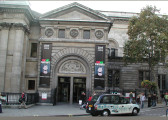Alma-Tadema: At Home in Antiquity
Originally published in July 2017 in American in Britain magazine Summer 2017
The Victorian artist Lawrence Alma-Tadema is famous for his gorgeous paintings of domestic interiors set in classical antiquity. Born in 1835 in the northern Netherlands, he trained at the Royal Academy of Fine Arts in Antwerp and was already an established artist by the time he settled with his family in London in 1870. Tadema’s work is remarkable for its technical skill, detail, perspective and sumptuous rendering of textiles, tiles and marble. His scenes of luxury and decadence have a recognisable signature style.
Alma-Tadema: At Home in Antiquity
By Abby Cronin
The Victorian artist Lawrence Alma-Tadema is famous for his gorgeous paintings of domestic interiors set in classical antiquity. Born in 1835 in the northern Netherlands, he trained at the Royal Academy of Fine Arts in Antwerp and was already an established artist by the time he settled with his family in London in 1870. Tadema’s work is remarkable for its technical skill, detail, perspective and sumptuous rendering of textiles, tiles and marble. His scenes of luxury and decadence have a recognisable signature style. The allure of classical themes was inspired by a visit to the rediscovered Roman town of Pompeii while on honeymoon in 1863 with his first wife. This was a watershed journey. Enthralled by the excavations of Pompeii he set about meticulously gathering data and taking measurements from sections of buildings, room and streets. His collection of archaeological drawings and photographs became a personal archive of source materials. His paintings are remarkable for their architectural accuracy and he was tagged the ‘archaeologist of artists’. Shortly after that visit, Pompeii began to come to life in his paintings.
A major exhibition of Alma-Tadema’s work can be seen in the Leighton House Museum. With more than 130 paintings and objects on display, this is the first retrospective exhibition in London since 1913. Leighton House, with its extraordinary Arab Hall, marble and mosaics is the perfect setting for Tadema’s work. Pictures by his second wife Laura, their daughter Anna and artists in his circle are included. The exhibit takes the form of a journey though the interior rooms of Leighton’s studio-house.
Artists’ Studio Houses
Leighton and Tadema were friends, prominent Royal Academicians who took enormous pride in their studio-homes. After Alma-Tadema’s first studio-house, Townshend House, suffered from a gas explosion on the Regent’s Canal, the family moved to an even grander house, Casa Tadema, on Grove End Road in St John’s Wood. Tadema’s two studio-houses were luxurious family homes which provided a rich source of artistic inspiration for picture-making. They served the needs of working artists and provided a place to entertain in the ample rooms furnished with an elaborate collection of antiques.
The lavishly decorated aesthetic interiors of Alma-Tadema’s Grove End Road home are portrayed in his painting, In My Studio, 1893. Here is visible evidence of the atmosphere and wealth in Casa Tadema. In My Studio captures a graceful model dressed in soft toga-like apparel, a reference frequently seen in Tadema’s Roman pictures. She has paused from her labours to enjoy the scents and textures of the studio. The influence of Tadema’s Northern European heritage is revealed in this contemporary domestic interior and paired incongruously with a hint of classicism, a duality he reconciled in subtle ways throughout his career. He gave this stunning painting to Frederic Leighton who hung it in the Silk Room of Leighton’s studio home in Holland Park Road. In exchange, Leighton gave Tadema a panel, The Bath of Psyche, which joined the other works in the Hall of Panels in Grove End Road.
Scenes set in classical antiquity are among his famous compositions. Two of the most well-known examples are the Roses of Heliogabalus, 1888 and The Finding of Moses, 1904. Alma-Tadema painted the Roses of Heliogabalus in London during the last few months of 1887. Since it was too cold for roses to be in bloom, he arranged for the flowers to be shipped from the French Riviera every week for as long as it took to complete the picture. The artwork depicts the third-century Roman emperor, Heliogabalus, reclining in a golden robe and tiara, and watching with indifference as his banquet guests suffocate in the sudden deluge of petals. Clearly Tadema tweaked classical history here, but the painting remains one of his most famous. The Finding of Moses was commissioned by Sir John Aird, engineer of the Aswan Dam in Egypt. In 1902 Alma-Tadema left London as Aird’s guest for the occasion of the opening of the dam. He brought home many sketches and used artistic license in this complex composition, the well-known Biblical story.
The Alma-Tadema Steinway Grand Piano
In the 1890s Tadema’s reputation as an eminent Victorian artist led to a major commission from the New York financier, art collector and philanthropist, Henry Gurdon Marquand, a founder member and then president of the Metropolitan Museum of Art in 1889. Marquand invited Alma-Tadema to create the Greco-Roman music room for his New York mansion. One of Tadema’s most famous paintings, A Reading from Homer, was painted for this room. But the showpiece for the Marquand music room was the Steinway grand piano, now in the permanent collection at the Clark Institute of Art in Williamstown, Massachusetts. Alma-Tadema designed the decoration for the piano along with a matching suite of furniture and textiles. Today twelve pieces of the original furniture along with paintings, ceramics, textiles and sculpture from the room will be brought together in an exhibition, Orchestrating Elegance, Alma-Tadema and Design, at the Clark Institute of Art. The Alma-Tadema piano pictured here may be “…the most beautiful piece of work, both in design and workmanship that I ever saw…” wrote Sir Edward Poynter, President of the Royal Academy (1836-1919) who had painted the panel above the keyboard.
By the beginning of the 20th century, High Victorian paintings were beginning to lose their popularity. Still, Alma-Tadema’s subject matter continued to influence the ideal of ‘Roman Life’ in the popular imagination. In the course of the 20th century, his work was an important visual reference in art, architecture, theatre and films. His commissions for theatrical designs led to active involvement in stage productions. The emerging film industry found Tadema’s scenes of antiquity valuable sources for set designs, costumes and ways to stage spectacular crowd scenes like the arena and the burning of Rome. Classical films of the 1950s and 1960s as well as silents from the 1910s referenced Tadema’s paintings. Of particular note is Ridley Scott’s Gladiator, 2000, which portrays a romantic vision of Rome and owes much to the artistic vision of Alma-Tadema. Long after his death in 1912 Tadema’s interpretation of classical antiquity continues to enthral and influence a wide range of artistic genres.
************************************************************
Exhibition: Alma-Tadema: At Home in Antiquity
Dates: 7 July 2017 – 29 October 2017
Leighton House Museum, 12 Holland Park Rd, London, W14 8LZ
www.leightonhouse.co.uk
Catalogue- Alma-Tadema: At Home in Antiquity. Published by Prestel, 2016
Images Courtesy Leighton House Museum Press Office
Exhibition: Orchestrating Elegance, Alma-Tadema and Design
Dates: 4 June – 4 September 2017
The Clark Institute of Art, Williamstown, Massachusetts. USA
http://www.clarkart.edu/
Image: Alma-Tadema Pianoforte. Courtesy Clark Institute of Art Press Office
____________________________________________________________________________
Get in Touch: Abby Cronin
artsjournalist@abbycronin.co.uk
Website: www.abbycronin.co.uk




